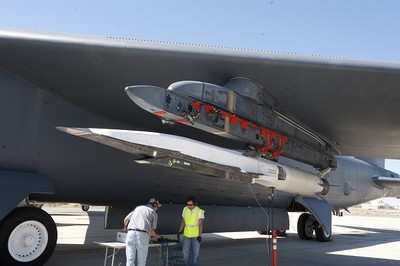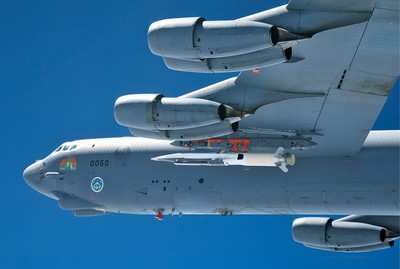Fri, Jun 17, 2011
Scramjet Failed To Develop Full Power
A second test of the X-51A Waverider flew June 13, 2011, in the
Point Mugu Naval Air Test Range over the Pacific Ocean, bringing
significant hypersonic research data in a less than successful
flight test. The hypersonic aircraft was successfully boosted to
just over Mach 5, and the scramjet engine lit but failed to
transition to full power.

Air Force Flight Test Center officials said after a flawless
flight from Edwards Air Force Base, a U.S. Air Force B-52H
Stratofortress released the experimental vehicle from an altitude
of approximately 50,000 feet. After release the X-51A was initially
accelerated by a solid rocket booster to a speed just over Mach
5.
The experimental aircraft's air breathing scramjet engine lit on
ethylene and attempted to transition to JP7 fuel operation when the
vehicle experienced an inlet un-start. The Waverider attempted to
restart and oriented itself to optimize engine start conditions but
was unsuccessful. The vehicle continued in a controlled flight
orientation until it flew into the ocean within the test range.

According to Charlie Brink, the Air Force Research Laboratory's
X-51A program manager, AFRL, Boeing and Pratt-Whitney Rocketdyne
engineers are reviewing the large amount of telemetry data
collected during the test flight to identify the cause of the
anomaly. "Obviously we're disappointed and expected better
results," said Mr. Brink, "but we are very pleased with the data
collected on this flight. I am extremely pleased with the AFFTC and
Point Mugu's support and execution of this complex flight test
mission, as they provided us every opportunity for success in this
endeavor. We have attempted two scramjet experiments now where one
successfully lit, and one did not. We will continue to examine the
data to learn even more about this new technology," he said. "Every
time we test this new and exciting technology, we get that much
closer to success."
Boeing and Pratt-Whitney Rocketdyne built four X-51A flight test
vehicles with the program goal of reaching Mach 6 in hypersonic
flight. The next flight is tentatively schedule for fall 2011.
More News
Pilot Applied Full Aft Stick And Nose-Up Trim, But The Airplane Remained On The Runway Analysis: The pilot reported that a preflight inspection and flight control checks revealed n>[...]
A Few Questions AND Answers To Help You Get MORE Out of ANN! 1) I forgot my password. How do I find it? 1) Easy... click here and give us your e-mail address--we'll send it to you >[...]
From 2022 (YouTube Edition): Before They’re All Gone... Humankind has been messing about in airplanes for almost 120-years. In that time, thousands of aircraft representing i>[...]
Advanced Air Mobility (AAM) A transportation system that transports people and property by air between two points in the NAS using aircraft with advanced technologies, including el>[...]
Aero Linx: MQ-1B Predator The MQ-1B Predator is an armed, multi-mission, medium-altitude, long-endurance remotely piloted aircraft that is employed primarily as an intelligence-col>[...]
 NTSB Final Report: Douglas A-4K
NTSB Final Report: Douglas A-4K ANN FAQ: Q&A 101
ANN FAQ: Q&A 101 Classic Aero-TV: PBY Catalina--From Wartime to Double Sunrise to the Long Sunset
Classic Aero-TV: PBY Catalina--From Wartime to Double Sunrise to the Long Sunset ANN's Daily Aero-Term (07.01.25): Advanced Air Mobility (AAM)
ANN's Daily Aero-Term (07.01.25): Advanced Air Mobility (AAM) ANN's Daily Aero-Linx (07.01.25)
ANN's Daily Aero-Linx (07.01.25)




